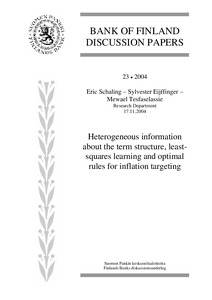Heterogenous information about the term structure, least-squares learning and optimal rules for inflation targeting
Schaling, Eric; Eijffinger, Sylvester; Tesfaselassie, Mewael (17.11.2004)
Numero
23/2004Julkaisija
Suomen Pankki
2004
Julkaisun pysyvä osoite on
https://urn.fi/URN:NBN:fi:bof-20140807341Tiivistelmä
In this paper we incorporate the term structure of interest rates into a standard inflation forecast targeting framework.Learning about the transmission process of monetary policy is introduced by having heterogeneous agents - ie central bank and private agents - who have different information sets about the future sequence of short-term interest rates.We analyse inflation forecast targeting in two environments.One in which the central bank has perfect knowledge, in the sense that it understands and observes the process by which private sector interest rate expectations are generated, and one in which the central bank has imperfect knowledge.In the case of imperfect knowledge, the central bank has to learn about private sector interest rate expectations, as the latter affect the impact of monetary policy through the expectations theory of the term structure of interest rates.Here, following Evans and Honkapohja (2001), the learning scheme we investigate is that of least-squares learning (recursive OLS) using the Kalman filter.We find that optimal monetary policy under learning is a policy that separates estimation and control.Therefore, this model suggests that the practical relevance of the breakdown of the separation principle and the need for experimentation in policy may be limited. Key words: learning, rational expectations, separation principle, Kalman filter, term structure of interest rates JEL classification numbers: C53, E43, E52, F33
